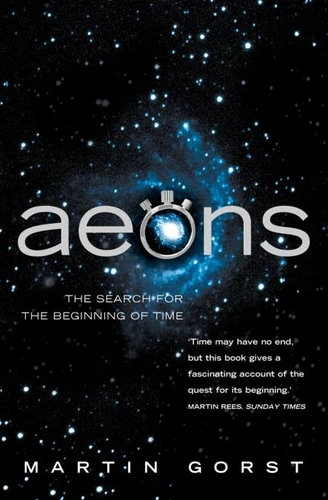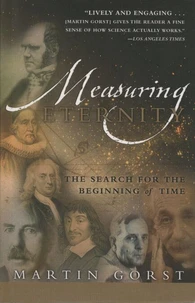Aeons. The Search for the Beginning of Time (Text Only)
Par :Formats :
Disponible dans votre compte client Decitre ou Furet du Nord dès validation de votre commande. Le format ePub protégé est :
- Compatible avec une lecture sur My Vivlio (smartphone, tablette, ordinateur)
- Compatible avec une lecture sur liseuses Vivlio
- Pour les liseuses autres que Vivlio, vous devez utiliser le logiciel Adobe Digital Edition. Non compatible avec la lecture sur les liseuses Kindle, Remarkable et Sony
- Non compatible avec un achat hors France métropolitaine
 , qui est-ce ?
, qui est-ce ?Notre partenaire de plateforme de lecture numérique où vous retrouverez l'ensemble de vos ebooks gratuitement
Pour en savoir plus sur nos ebooks, consultez notre aide en ligne ici
- Nombre de pages320
- FormatePub
- ISBN978-0-00-750297-4
- EAN9780007502974
- Date de parution07/03/2013
- Protection num.Adobe DRM
- Infos supplémentairesepub
- ÉditeurFourth Estate
Résumé
The full story of man's attempt to discover the moment that time began, from James Ussher's confident assertion in 1650 that the world was 5, 654 years old to the Hubble Space telescope's images of a world 13 billion years old, with a starry cast of eccentrics, mystics, scientists and visonaries.
The moment of the beginning of time is one of science's Holy Grails, pursued by devotees and obsessives across the ages.
Few were more committed than Bishop James Ussher who lost his sight in his 50 year quest, laboriously outlined in his 2000 Latin pages of Annals - a chronology of all known history - that is now famous only for one spectacularly inaccurate date: 4004BC, the creation of the world. Theology failed Ussher, just as it thwarted Theophilus of Antioch and many others before him. Geology was next to fail the test of time: the Comte de Buffon, working out the rate at which the earth was supposed to have cooled came up with age of 74, 832 years even though he suspected this was far too little.
Biology had a go in the eighteenth century in the hands of Johann Scheuchzer, who alleged that a fossil he had found was of a man at the time of Noah's flood; regrettably what he had was a large salamander. And so science inched forward via Darwinism, thermodynamics and radioactivity - each new discovery being applied to the enduring mystery: when had time begun. Until now where telescopes of remarkable vision offer a glimpse of the answer, but the moment may prove to be indefinable just as we are on the verge of locating it.
Few were more committed than Bishop James Ussher who lost his sight in his 50 year quest, laboriously outlined in his 2000 Latin pages of Annals - a chronology of all known history - that is now famous only for one spectacularly inaccurate date: 4004BC, the creation of the world. Theology failed Ussher, just as it thwarted Theophilus of Antioch and many others before him. Geology was next to fail the test of time: the Comte de Buffon, working out the rate at which the earth was supposed to have cooled came up with age of 74, 832 years even though he suspected this was far too little.
Biology had a go in the eighteenth century in the hands of Johann Scheuchzer, who alleged that a fossil he had found was of a man at the time of Noah's flood; regrettably what he had was a large salamander. And so science inched forward via Darwinism, thermodynamics and radioactivity - each new discovery being applied to the enduring mystery: when had time begun. Until now where telescopes of remarkable vision offer a glimpse of the answer, but the moment may prove to be indefinable just as we are on the verge of locating it.
The full story of man's attempt to discover the moment that time began, from James Ussher's confident assertion in 1650 that the world was 5, 654 years old to the Hubble Space telescope's images of a world 13 billion years old, with a starry cast of eccentrics, mystics, scientists and visonaries.
The moment of the beginning of time is one of science's Holy Grails, pursued by devotees and obsessives across the ages.
Few were more committed than Bishop James Ussher who lost his sight in his 50 year quest, laboriously outlined in his 2000 Latin pages of Annals - a chronology of all known history - that is now famous only for one spectacularly inaccurate date: 4004BC, the creation of the world. Theology failed Ussher, just as it thwarted Theophilus of Antioch and many others before him. Geology was next to fail the test of time: the Comte de Buffon, working out the rate at which the earth was supposed to have cooled came up with age of 74, 832 years even though he suspected this was far too little.
Biology had a go in the eighteenth century in the hands of Johann Scheuchzer, who alleged that a fossil he had found was of a man at the time of Noah's flood; regrettably what he had was a large salamander. And so science inched forward via Darwinism, thermodynamics and radioactivity - each new discovery being applied to the enduring mystery: when had time begun. Until now where telescopes of remarkable vision offer a glimpse of the answer, but the moment may prove to be indefinable just as we are on the verge of locating it.
Few were more committed than Bishop James Ussher who lost his sight in his 50 year quest, laboriously outlined in his 2000 Latin pages of Annals - a chronology of all known history - that is now famous only for one spectacularly inaccurate date: 4004BC, the creation of the world. Theology failed Ussher, just as it thwarted Theophilus of Antioch and many others before him. Geology was next to fail the test of time: the Comte de Buffon, working out the rate at which the earth was supposed to have cooled came up with age of 74, 832 years even though he suspected this was far too little.
Biology had a go in the eighteenth century in the hands of Johann Scheuchzer, who alleged that a fossil he had found was of a man at the time of Noah's flood; regrettably what he had was a large salamander. And so science inched forward via Darwinism, thermodynamics and radioactivity - each new discovery being applied to the enduring mystery: when had time begun. Until now where telescopes of remarkable vision offer a glimpse of the answer, but the moment may prove to be indefinable just as we are on the verge of locating it.




